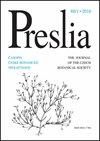Oak-hornbeam forests of central Europe
IF 4.4
2区 生物学
Q1 PLANT SCIENCES
引用次数: 14
Abstract
Oak-hornbeam forests (order Carpinetalia) are a widespread vegetation type in central Europe. As vegetation ecologists focused on them since the pioneering times of vegetation research, many syntaxonomic units are described. However, classification systems used in various central European countries suffer from inconsistencies and overlaps of the concepts of particular associations. Currently there is no consistent syntaxonomic system based on numerical analysis of vegetation plots that would be valid for the whole of central Europe. Therefore, the main goal of this study is to provide a revised syntaxonomic system of oak-hornbeam forests across central Europe, develop formal definitions of the associations and include these definitions in a classification expert system. We recognized 13 associations, 9 from the alliance Carpinion betuli (central European oak-hornbeam forests) and 4 from the alliance Erythronio-Carpinion (Illyrian and northern Italian oak-hornbeam forests). We prepared an expert system that classified 55% of the releves in a central European oak-hornbeam forest dataset (n = 6212) at the association level. To stabilize the Carpinion betuli association names, we selected nomenclatural type releves for associations that have not been typified so far. In addition, two association names (Poo chaixii-Carpinetum and Pseudostellario-Carpinetum) were validated. Ordination revealed the main drivers of species diversity in these forests, including a complex gradient of soil moisture, nutrient availability and geographical position (mainly latitude). Among the climate variables, annual temperature amplitude and mean annual temperature were most closely correlated with species composition.欧洲中部的橡树角木森林
橡角木林(橡角木目)是中欧一种广泛分布的植被类型。由于植被生态学家从植被研究的先驱时代就开始关注它们,因此描述了许多分类学单位。然而,在不同的中欧国家使用的分类系统遭受不一致和重叠的概念的特定协会。目前还没有一种基于植被样地数值分析的一致的分类学系统,可以适用于整个中欧。因此,本研究的主要目标是提供一个修订的中欧橡树角梁林分类学系统,制定正式的关联定义,并将这些定义纳入分类专家系统。我们确认了13个协会,9个来自Carpinion betuli联盟(中欧橡树角梁林),4个来自Erythronio-Carpinion联盟(伊利里亚和意大利北部橡树角梁林)。我们准备了一个专家系统,在协会层面上对中欧橡树-角梁森林数据集(n = 6212)中55%的树木进行了分类。为了稳定Carpinion betuli关联名称,我们选择了迄今为止尚未类型化的关联的命名类型相关。此外,还对两个关联名称(Poo chaixii-Carpinetum和Pseudostellario-Carpinetum)进行了验证。排序揭示了这些森林物种多样性的主要驱动因素,包括土壤湿度、养分有效性和地理位置(主要是纬度)的复杂梯度。在气候变量中,年温幅值和年平均气温与物种组成的关系最为密切。
本文章由计算机程序翻译,如有差异,请以英文原文为准。
求助全文
约1分钟内获得全文
求助全文
来源期刊

Preslia
生物-植物科学
CiteScore
5.20
自引率
29.40%
发文量
8
审稿时长
>12 weeks
期刊介绍:
Preslia is a peer-reviewed scientific journal publishing original research papers on plant systematics, morphology, phytogeography, ecology and vegetation science, with a geographical focus on central Europe. The journal was founded in 1914 and named in honour of brothers Jan Svatopluk Presl (1791–1849) and Karel Bořivoj Presl (1794–1852), outstanding Bohemian botanists. It is published quarterly by the Czech Botanical Society.
 求助内容:
求助内容: 应助结果提醒方式:
应助结果提醒方式:


